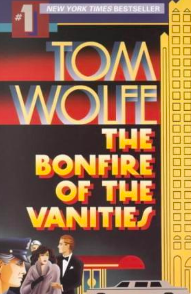
Hypothetical: If you had to choose a novel written by somebody else, that you wish you had written, what would it be?

Dutch Post-Impressionism master Vincent Van Gogh was a phenomenal force who helped shape modern art culture. His influence ranks with Shakespeare in literature, Freud in psychology, and The Beatles in music. Van Gogh was also plagued with mental illness, suffered from depression, and was tormented by psychotic episodes.
Conventional history records that Van Gogh died from a self-inflicted gunshot wound in 1890 at the age of 37. However, an independent and objective look at the case facts arrives at an entirely different conclusion—Vincent Van Gogh was actually shot by someone else, and it was deliberately covered up.
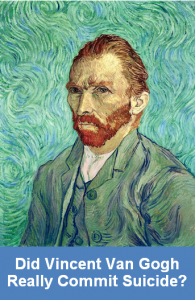 This isn’t to say that Van Gogh was murdered as in an intentional homicide case. As a former police investigator and coroner, I’m well familiar with death classifications. The civilized world has long used a universal death classification system with five categories. They are natural death, accidental death, death caused by wrongful actions by another human being which is a homicide ruling, self-caused death or suicide, and an undetermined death classification when the facts cannot be slotted into one conclusive spot.
This isn’t to say that Van Gogh was murdered as in an intentional homicide case. As a former police investigator and coroner, I’m well familiar with death classifications. The civilized world has long used a universal death classification system with five categories. They are natural death, accidental death, death caused by wrongful actions by another human being which is a homicide ruling, self-caused death or suicide, and an undetermined death classification when the facts cannot be slotted into one conclusive spot.
I’m also familiar with gunshot wounds. Understanding how Vincent Van Gogh’s fatal wound happened is the key to determining if he intentionally shot himself, if he accidentally caused his own death, or if someone else pulled the trigger which killed Van Gogh. Before analyzing what’s known about the Van Gogh case facts, let’s take a quick look at who this truly remarkable man really was.
Vincent Willem Van Gogh was born in 1853 and died on July 29, 1890. During Van Gogh’s life, he produced over 2,000 paintings, drawings, and sketches. He completed most of these in his later years and was in his most-prolific phase when he suddenly died.
Van Gogh didn’t achieve fame or fortune during his life. He passed practically penniless. It was after death when the world discovered his genius and assessed his works of bright colors, bold strokes, and deep insight as some of the finest works ever to appear on the art scene. Today, an original Van Gogh is worth millions—some probably priceless.
Vincent Van Gogh achieved artistic saint status. It’s not just Van Gogh’s unbounded talent that supported his greatness. It’s also the mystique of the man and the martyrdom mushrooming from his untimely death that robbed the world of an artist—a starving artist and a man who lived on the fine line between genius and nut.
Most people know some of Van Gogh’s masterpieces. Wheatfield With Crows may have been his last painting. Café Terrace At Night, The Potato Eaters, Irises, Bedroom In Arles, The Olive Trees, and Vase With Fifteen Sunflowers are extraordinarily famous. So is The Starry Night. (I happen to have a hand-painted oil reproduction of Starry Night right on the wall in front of me as I write this, and my daughter has Café de Nuit hanging in her home.)
Most people know the story of Vincent Van Gogh’s ear. It’s a true story, but the truth is he only cut part of his left ear off with a razor during a difficult episode with his on-again, off-again relationship with painter Paul Gauguin. The story goes on to say that Van Gogh gave the piece of his ear to a brothel lady, then he bandaged himself up and painted one of many self-portraits. I just looked at this portrait (Google makes Dutch Master shopping easy) and was struck by the image of his right side being bandaged. Then I realized Van Gogh painted selfies by looking in a mirror.
And most people know something about Vincent Van Gogh’s time in asylums. This is true, too, and he spent a good while of 1889 in Saint-Remy where he stared down on the town and painted The Starry Night from later memory. The celestial positions are uncannily accurate.

In late 1889, Van Gogh moved to a rooming house in Auvers-sur-Oise near Paris. His painting production went into overdrive, and he was at the peak of his game. On July 27, 1890, Van Gogh left his room with his paints, canvas, and easel. He returned empty-handed with a bullet in his belly.
Vincent Van Gogh’s spirit left this world at 1:30 a.m. on July 29. He passed without medical intervention at his bed, and the medical cause was, most likely, exsanguination or internal bleeding. There was no autopsy, and Van Gogh was buried in a nearby churchyard the next day.
There are various ambiguous statements purported from Van Gogh. He did not admit to shooting himself or intentionally attempting to commit suicide. However, the record indicates he didn’t deny it. The record can also be interpreted that he covered up for someone else.
What is fairly clear is the description of Vincent Van Gogh’s gunshot wound. There are conflicting locations, (chest, stomach, abdomen), but this is explainable from Dutch/French to English translations. It’s highly probable that one bullet entered the left side of Van Gogh’s mid-section and traversed his intestines in a left-to-right direction. There was no exit wound and no serious spinal damage as Van Gogh had walked home from the shooting scene, up the stairs, and to his room where he expired a day and a half later.
There was no firearm found and absolutely no history of Vincent Van Gogh ever owning or operating a gun. He was a painter. Not a hunter or soldier. (Note: There was a rusted revolver found in an Auver field in 1960 which was said to be the weapon. There is no proof that it was.)
There was no suicide note or any deathbed confession. Aside from being an artist, Van Gogh was a prolific writer who documented many thoughts as he progressed from mental sickness to physical health. In late July of 1890, Van Gogh’s writings showed him to be optimistic and with plans to paint as much as possible before an anticipated period of blackness returned. Two days before his death, Van Gogh placed a large art supply order.

Suicide, in Van Gogh’s case, wasn’t surfaced in the early years after his death. There were murmurs among the villagers that “some young boys may have accidentally shot” Van Gogh as he went about his work in a nearby field. There was no coroner’s inquiry or inquest, but there is documentation of a gendarme questioning Van Gogh if he intentionally shot himself to which Van Gogh allegedly replied, “I don’t know.”
The first strong suicide suggestion came in 1956 with Irving Stone’s novel and movie Lust For Life. It was a documentary that took liberty with Van Gogh’s life and times. It concluded Van Gogh was a troubled soul—a beautiful soul—who ended his life intentionally. The book and movie were bestselling blockbusters and cemented the suicide seed to an adorning public.
It became ingrained in lore and public acceptance that Vincent Van Gogh was a desponded psychotic who suddenly up and killed himself rather than continue a tormented existence of interpreting beauty in nature and people. It was the gospel, according to Van Gogh historians, who were comfortable with a suspicious explanation.
Other people weren’t. In 2011, two researchers took a good and hard look into Van Gogh’s life and death. They had full access to the Van Gogh Museum’s archives in Amsterdam and spent enormous time reviewing original material. They found a few things.
One was a 1957 interview with Rene Secretan who knew Van Gogh well. Secretan admitted to being one of the boys spoken about by the villagers who were involved in Van Gogh’s shooting. Rene Secretan, sixteen years old in 1890, told the interviewer he wanted to set the distorted record straight that was misrepresented in the book and movie.
The interview documents Rene Secretan as saying the handgun that shot Van Gogh was his, and that it was prone to accidentally misfiring. Secretan self-servingly denied being present when the accidental shooting happened, claiming he was back in Paris and not at his family’s summer home in Auvers. Secretan failed to identify those directly involved or exactly what circumstances unfolded.
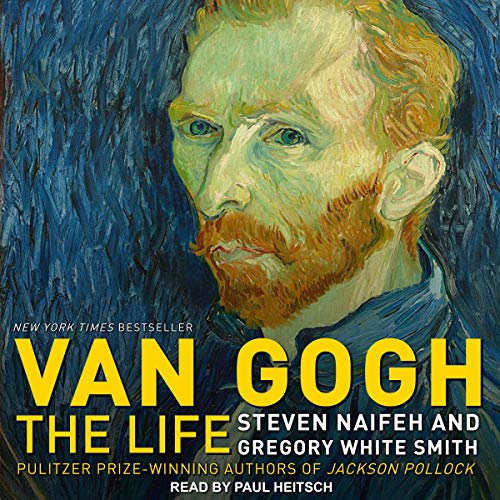 The researchers, Pulitzer Prize winners Steven Naifeh and Gregory White Smith who co-wrote Van Gogh: The Life, found corroborating statements placing Van Gogh near the Secretan villa on the afternoon of the shooting. They also sourced a leading expert on firearms and gunshot wounds who refuted any chance of Van Gogh being able to discharge a firearm with his own hands that could have caused the wound in its documented location.
The researchers, Pulitzer Prize winners Steven Naifeh and Gregory White Smith who co-wrote Van Gogh: The Life, found corroborating statements placing Van Gogh near the Secretan villa on the afternoon of the shooting. They also sourced a leading expert on firearms and gunshot wounds who refuted any chance of Van Gogh being able to discharge a firearm with his own hands that could have caused the wound in its documented location.
Dr. Vincent Di Maio (a 2012 key witness in the Florida trial of George Zimmerman who shot African-American youth Trayvon Martin in a neighborhood watch altercation) concluded that Van Gogh, who was right-handed, could not possibly have held a firearm as it had to be; therefore the shot had to have been fired by another party. Dr. Di Maio also commented on the lack of reported gunshot residue on Van Gogh’s hands and clothes. In 1890, most cartridges contained black powder which was filthy stuff when burned at close range.
Researchers Naifeh and Smith also took a deep dive into what they could find on Rene Secretan’s background. They painted him as a big kid—a thug and a bully who was well known to have picked on wimpy Van Gogh throughout the month of July 1890. Secretan came from a wealthy Paris family who summered at Auvers with their second home within walking distance of Van Gogh’s rooming house.
According to the researchers of Van Gogh: The Life, Rene Secretan had seen the Buffalo Bill Wild West show in Paris, and Secretan fancied himself as a cowboy character. Secretan fashioned a costume to go with his cocky role of a western gunfighter, and he acquired a revolver that was prone to malfunction. They documented incidents where Secretan would mock Van Gogh as he painted, play pranks on him, and supply alcohol to Van Gogh who couldn’t afford it.
It was during a mocking spat, the researchers surmise, that somehow Secretan’s revolver went off and struck Van Gogh in the abdomen. According to the theory, the boys fled, disposed of the weapon, and formed a pact of silence. If this was true, the question arises of why didn’t Vincent Van Gogh report the truth, and why has the suicide conclusion remained steadfast.
Naifeh and Smith address this in their book with this quote: When all this (accidental shooting theory) began to emerge from our research, a curator at the Van Gogh Museum predicted the fate that would befall such a blasphemy on the Van Gogh gospel. “I think it would be like Vincent to protect the boys and take the ‘accident’ as an unexpected way out of his burdened life,” he agreed in an e-mail. “But I think the biggest problem you’ll find after publishing your theory is that the suicide is more or less printed in the brains of past and present generations and has become a sort of self-evident truth. Vincent’s suicide has become the grand finale of the story of the martyr for art, it’s his crown of thorns.”
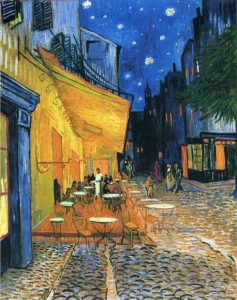
As an experienced cop and a coroner, I think Naifeh and Smith are on to something. There are two huge problems with a suicide conclusion in classifying Vincent Van Gogh’s death. One is the lack of an immediate suicide threat. The other is the gunshot nature.
I’ve probably seen fifty or more gunshot suicides. All but one were self-inflicted wounds to the head. The exception was a single case where a shotgun was placed against the chest and the pellets blew apart the heart. I have never seen a suicide where the decedent shot themselves in the gut, and I’ve never heard of one.
Vincent Van Gogh didn’t leave a suicide note. He made no immediate suicide threats and, by all accounts, things were going well for the struggling artist. It makes no sense at all that Van Gogh would head out for a summer’s day, begin to paint, produce a gun from nowhere, shoot himself in the stomach from the most inconceivable position, then make it home—wounded—without finishing himself off with a second shot.
If I were the coroner ruling on Vincent Van Gogh’s death, I’d readily concur the cause of death was slow exsanguination resulting from a single gunshot wound to the abdomen. I’d have a harder time with the classification. Here, I’d have to use a process of elimination from the five categories—natural, homicide, accidental, suicide, or undetermined.
There is no possibility Van Gogh died of natural causes. He was shot, and that is clear. Was he murdered or otherwise shot intentionally? There is no evidence to support an intentional homicide classification. Did the firearm go off accidentally? It certainly could have, and there is information to support that theory but not prove it.
Suicide? Not convincing. The available evidence does not meet the Beckon Test where coroners must establish beyond a reasonable doubt that the decedent intentionally took their own life. If the death circumstances do not fulfill the requirements of the Beckon Test, then a coroner is not entitled to register a suicide classification.
This only leaves undetermined. Coroners hate closing a file with an undetermined classification. It’s like they failed in their investigation.
Unfortunately, in Vincent Van Gogh’s case—from the facts as best as are known—there’s no other conclusion than officially rule “Undetermined”.
I’m no longer a coroner, though, so I’ll stick out my neck.
On the balance of probabilities, I find Vincent Van Gogh was accidentally shot, then sadly died from this unintended and terrible tragedy.
——–
Kill Zoners – Does this theory of Vincent Van Gogh’s death circumstances make sense to you? Have you heard it before? And are you a VVG artwork fan – do his creations speak to you?
A few months ago, I was asked and agreed to participate in a first of its kind literary event at the Berkeley County-Martinsburg Public Library here in my new West Virginia hometown. It would be a meet-n-greet, book signing supported by Four Seasons Books in Shepherdstown, WV. A few weeks later, the organizers reached out again and asked if I would mind if a second author joined the event. Magnanimous fellow that I try to be, I agreed right away, then asked for the other author’s name and genre. I had never heard of the name, probably because the genre was romance.
Well, that would be different, wouldn’t it? I’d never done a panel that mashed up romance and thrillers. I even agreed to promote the event on my radio show and put it out on my Facebook feed as the time approached.
About two weeks out, the organizers sent an email about how to get tickets for this event.
Wait. What? Tickets? In advance? They were free, but they were required to get through the door. This was new to me, and I’ve been doing this stuff for a long time. When I clicked on the link to the tickets and discovered that the event was already sold out, I said to myself, “Self, you should have taken this romance writer you’ve never heard of more seriously.”
Not that anything would have changed.
It turns out that Jennifer L. Armentrout, a delightful, fabulously successful #1 New York Times bestselling author does not write romance. She writes . . . wait for it . . . young adult paranormal sci-fi romance. And she lives about eight miles from me. A bit of a recluse, I believe her when she says she has not taken a vacation or even a weekend off in over 10 years. That’s how she’s been able to churn out 60 books in that period of time. But she’s wildly active on social media, so when she announced that her fans could meet her in Martinsburg . . .
The event.
When I arrived at the library and was ushered to the second floor to the green room, I still didn’t get it. Worse, I didn’t think the library got it. They’d cleared out the entire space–bookshelves and everything–and set up hundreds of chairs. Who the hell was going to fill them?
The the human spigot opened. At 1:50, ten minutes before the event was to start, people started flowing up the stairs, each of them sporting a yellow wrist band that proved they’d been ticketed. Nearly all carried books, many carried bags of books. None of the books bore one of my covers. I have never seen such a rainbow of different hair colors, or variety of facial piercings and tattoos. I put the median age at twenty-three–twenty-five, max.
The discussion.
Once everyone was seated, the moderator introduced Jennifer and me, and we took our places behind the long table next to the display of our books. The light hearted banter we’d developed in the green room transferred well onto the stage and the audience laughed a lot, so a good time was had by all.
For me, though, there was one truly sobering moment–the one that demonstrated just what a dinosaur I am in this business. The question was something like, “Tell us how you sold your first book. How did you find your agent, you know how did all of that work?”
Jennifer answered first. The only part I remember is, “I sold my first book in 2012, and I . . .” From there, she ground through social media/computer-speak that clearly made perfect sense to the audience but meant nothing to me. She talked about promotional sites I’d never heard of and something really big on TikTok. The whole time she was speaking, my brain was screaming, oh, shit, I’m next!
When it was my turn, I played the truth for a laugh. In 1994, after I finished marking up the pages of a book called Writer’s Digest Guide to Literary Agents, I sent my query letter and self-addressed stamped envelope . . .
It’s an entirely different world now.
The signing.
I’ve signed next to Lee Child and Mary Higgins Clark. I have never seen fans as passionate as the ones who stood in line for three hours to have their books signed by Jennifer L. Armentrout. One fan had driven overnight from Buffalo to be there, and another had taken a train from Connecticut. At least two fans were so overwhelmed that they cried.
I’m happy to say that I sold and signed a dozen or so books, too, but to be honest, they felt like sympathy sales. As much as I tried not to look sad and lonely as I was largely ignored, maybe I didn’t quite pull it off.
Lessons learned.
First, I learned that there’s a genre called young adult paranormal sci-fi romance.
More importantly, I experienced my first vivid, first-person demonstration of the power of social media to spread word of an event. Unfortunately, I think there’s a generational component to those particular social media outlets. I could be wrong, but I don’t see TikTok as a destination for the average Jonathan Grave fan.
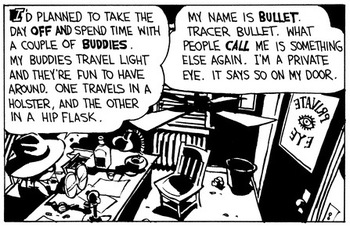
Credit: From the site TVtropes.org
“The rain was comin’ down like all the angels in heaven decided to take a piss at the same time. When you’re in a situation like mine, you can only think in metaphors.” — Dick Justice, Max Payne 2: The Fall of Max Payne
Maybe I’m just hanging around the wrong people these days.
I’ve been lucky to have some free time this month so am reading for pleasure. But have started and put aside four books. It didn’t dawn on me until this week why: The protagonists are all hot messes. Maybe it’s because I see enough losers in real life that my patience with fictional ones has snapped its last thread. Coupled with the fact that every character on TV seems damaged, deranged or just too ditzy to live.
Now, we all love a flawed protagonist. Their personal journey is a parallel track that runs along side the main murder plot and creates interest and empathy. But man, does everyone have to be addicted, divorced, friendless, childless, and beset with demons from their screwed up childhoods? Do we really need another detective whose only steady relationships are with Cutty Sark and John Coltrane?
I really wish I could name names here because I hit some passages that are really worth quoting to make my point. And none of these books are old noir. Each is of recent vintage and a couple are big-name writers.
This all dovetailed with a recent Facebook post by my writer-friend and Shamus winner Rick Helms. He’s on a cruise with lots of time to read, but he, like me, has lost patience. To quote:
[I’m] relaxing with a generally well-written private eye novel by a writer new to me. Like many PI novels these days the protagonist is almost painfully damaged. Whether it’s alcohol, drugs, gambling, or just plain paralyzing depression or grief, a large segment of the mystery writing community frequently writes broken protags. Some of these characters have been very critically successful. I have sort of a different take. I tend to regard emotionally damaged protags as a bit of a crutch.
Sure, I’ve written them…[my PI] Pat Gallegher is a gambling addict dragging half a century of failure behind him like a Dickens ghost. My small town police chief Judd Wheeler has PTSD and panic attacks. My forensic psychologist Ben Long presents with a dramatically exaggerated version of my own high-functioning autism. In each case, however, they are coping adequately with their difficulties. While they may experience distress, they don’t wallow in it. None of them wakes up hung over to a living room strewn with pizza boxes and beer bottles and days of dishes piled in the sink (the universal literary language for desperation and giving up). They are managing well despite their problems. Their personal tragedies impact their lives, but they aren’t the story itself.
Rick goes on to say he’s old enough to remember reading the lastest new releases by Ross Macdonald and his own work is influenced by Chandler, Robert B. Parker, Brett Halliday, and the like. He, like me, has a special love of Macdonald. To quote:
Lew Archer TOLD the stories of his investigations. He never WAS the story. The pathos and distress in his stories were always portrayed by the people he interviewed in the course of his investigations. He regards a murder victim or an oil spill in Santa Barbara with the same dispassionate observations as he might describe a businessman’s special baseball game. Archer is an observer of tragedy, seldom reacting to it with more than average empathy. He cares, but he doesn’t lose himself in his investigation. In the end, he walks away with little observable growth or change in his basic character, because he was never broken in the first place. The story was never about him. It was about solving the case.
He also cites Parker’s Spenser as a relatively mentally healthy and confident guy doing a tough job while maintaining a long-term relationship. He cares about people, but — with the possible exception of when Ruger nearly killed him in Small Vices — he rarely allows his own personal condition to do much more than put a hitch in his giddy-up.
Likewise, as Rick points out, “We know little of Phillip Marlowe’s inner emotions and mental functioning. We know his opinions, because Chandler was full of them, mostly of the sardonic variety. But nobody would refer to Marlowe as damaged.”
When did the shift to a protag’s personal journey begin? I’m not well-read in the old stuff to even guess. But I do know I’m weary of the dreary dick. Is it time to call them out as the tired cliches they are?
Okay, we have to stop and back up. Time for definitions. I love definitions. They bring clarity to fuzzy topics like this. Is a cliche the same thing as a trope? Or is the latter just an uppity word for the former? Lemme give it a go:
Cliche: Using certain phrases, expressions, devices, or archetypes that have been used so much they lose freshness. Maybe they were once intriguing, but when readers see something too often, they become desensitized, and the idea no longer carries the currency it once had. Examples: the naive female rookie patronized by boss and colleagues. (Tyne Daly, playing clean Kate to Eastwood’s dirty Harry?) The slimy defense lawyer. The good-cop-bad-cop. The crabby lieutenant who suspends a rogue underling. The PI who gets the crap beat out of him but jumps out of bed the next morning all dishy and doodle. Add your own to the list…
Trope: A familiar character type, plot point, setting, or writing style that has become instantly recognizable to readers. Very common in genre novels and when done well, every effective. Examples: In the romance, “enemies to lovers” trope (lifted from Jane Austen). The lone gunslinger and embattled sheriff. (Come back, Shane!)
Most folks conflate cliches and tropes but they are distinctly different. Tropes can be good things, helping a character to come across as an old friend or making classic situations feel fresh again (think Romeo and Juliet transformed into West Side Story.)
Time for some Joseph Campbell here. In his The Hero With a Thousand Faces, he drew upon works by psychoanalyst Carl Jung to develop recognizable literary archetypes. According to Campbell, everyone from Homer’s Odysseus to Neo in The Matrix is living out the same epic story. George Lucas credits Campbell for the Star Wars trilogy, using the King Authur trope to create boy-king Luke Skywalker, who gets a magic sword, is guided by an old mentor, and storms a castle to save a princess.
One of my favorite tropes is Austen’s Mr. Darcy. He’s handsome, mysterious, sexy. I loved how Helen Fielding used him in Bridget Jones’s Diary: “It struck me as pretty ridiculous to be called Mr. Darcy and to stand on your own looking snooty at a party. It’s like being called Heathcliff and insisting on spending the entire evening in the garden, shouting ‘Cathy’ and banging your head against a tree.”
Let’s face it, crime fiction is at its heart tropian. We rely on situations (crimes, usually murder), archetypes (loner cop holding out for justice) and even some “rules,” which of course can be broken.
But how do you honor the great traditions of our genre without being banal? How do you cleave to such a well-worn path and still give your readers some new vistas? How do you utilize trope and not slide downhill into cliche?
Our dilemma is that a story has to feel new and yet be familiar enough to be recognized as part of the genre. Writers often want to pay homage to their favorites from the past, but characters have to distinguish themselves in their own present or they petify into stereotypes. In the early books, Spenser seemed a Marlowe knockoff, but Parker quickly made him into his own man.
Years ago, I got into a lengthy blog discussion on this subject with a bunch of crime writers. Luckily, I kept this quote from Brian Lindenmuth: “the PI novel is the haiku of the mystery genre; there may be only 17 syllables but in the right hands those syllables will sing. There is the potential for a lot of power in that framework.”

I liken crime writing to classical ballet. There are only five positions for the feet and arms in ballet. But within that strict framework, anything is possible, from swoony-romanticism of Swan Lake to George Balanchine’s Stravinsky-twitchy Agon.
The trick, if it can be simplified as such, is that you have to take our beloved tropes and turn them into your own, like Fielding did with Emma and Bridget Jones. A while back, I contributed a short story to an anthology whose theme was honoring the PI tradition. Being on a John D. McDonald binge back then, I decided to create a female McGee whose business card read: Mavis Magritte, Salvage Consultant, Slip C12, Duncan Clinch Marina, Traverse City, Michigan. I had a ball writing that thing. Mavis has to prove her best friend Eunice Meijer didn’t kill her creepy lover Dirk. And yes, they drink gin.
Trope on, crime dogs. In the meantime, take some inspiration from the pas de deux from Balanchine’s Agon.
Have you ever received a text from a family member or close friend and knew something was wrong even though the words indicated the opposite?
I’ll show you what I mean with a real-life example.
The Kid planned to drive up to deliver ducks to the couple who lives at the top of our mountain, off-the-grid in a year-round camp surrounded by tall pines, oak, birch, and maple trees. By 10 a.m. that morning, we still hadn’t heard from The Kid, which is unusual. He’s always been an early riser.
So, I shot him a text. “Still planning to come up today?”
Several minutes dragged by before he responded. “Yes.”
My intuition tapped me on the shoulder. Something’s wrong. He never responds with one word. Besides, a simple yes didn’t give me enough information. If he brought all three grandkids, I would need to plan to feed six rather than three.
Plus, I let my little fur-babies run around my office during the day, but our grandchildren have a habit of leaving doors open. So, when they visit, it’s safer to leave them in their guinea pig habitat.
I texted back, “The Joe and the chicks coming, too?”
Another long pause. “Just The Joe.”
“You okay? You sound… I dunno… off.”
The Kid knows I’m tuned into him. Over the years I’ve learned to trust my intuition, and it has never failed me. Lying would be pointless.
“I was chasing ducks.”
“Okay, cool,” I texted, but something told me “chasing ducks” wasn’t the full story. Regardless, I didn’t want to push the issue via text. “I get the feeling you won’t be staying long.”
“We can stay for a bit.” The five-minute pause seemed to last twenty. “The longer the better. LOL”
And there it was—the first hint of the real reason he seemed off. Which he’d spill in person. It’s much harder to hide behind a false façade while staring into a concerned parent’s eyes. Though I’d never want to come across as pushy—he is a grown man, after all—I can’t take it when my kid is hurting. I don’t care how old he is. I’ll always be fiercely protective of his beautiful heart.
I do have a point to all this.
With that one simple word—Yes—I, the reader, knew to pay attention. That yes held power. That yes held unlimited power, more powerful than if he’d written an entire paragraph.
Writers should do the same. It’s a simple but effective way to add tension to a scene, cause a disturbance, and cue the reader to pay attention. The one-word, staccato sentence is a tool used for emphasis.
Run. Now.
It’s short and to the point. It calls attention to itself and exploits a reader’s emotions. Varying sentence structure holds a reader’s attention.
The following example looks like an exaggeration, but I once had to critique the first few pages of a novel written just like it.
As he stared at me, I could not look away. As I moved around the room, his stare held me hostage. As he moved closer, I told him to stop. As I backed away, he kept coming.
Every sentence began with “As” for three, never-ending pages. Not only is it grueling and repetitive, it’s annoying to read.
Rewrite:
His wolf-like stare held me hostage. Stop. Please stop. He moved closer. I backed away. Dear God, no. Not again. My spine hit the wall, my fingers searching behind me for the doorframe.
See how much more immediate the second example sounds? We don’t want to overdo it, but nothing can replace a well-placed staccato sentence here and there.
Writers have access to a plethora of writing tips, but it’s important not to overlook simple ways to hone our craft, like the act of reading and sentence structure.
Thoughts? Let’s discuss.
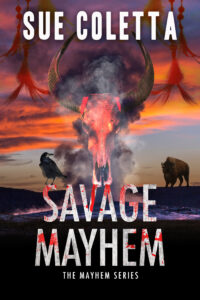
Warriors battle a ruthless animal trafficking ring in Yellowstone. They will protect the sacred lineage of American Buffalo by any means necessary.
Even murder.
Download a sample on Amazon
by James Scott Bell
@jamesscottbell
On occasion a writer is tapped to make some remarks in a public setting. For some, this is as enticing as a root canal, or being forced to watch The Golden Bachelor. We’ve given out some good advice on public speaking here at TKZ (you can use the search box). Today, I’d like to talk about things you should never do when giving a speech.
To help me out, I call upon the great American humorist Robert Benchley. Benchley came to prominence with a stage performance called “The Treasurer’s Report.” It was a hilarious bit about a befuddled man trying to make a dull presentation somewhat entertaining. It was turned into a short film in 1928 and is one of the earliest “talkies” ushered in by The Jazz Singer.
Benchley gave a similar performance the 1943 movie The Sky’s the Limit, starring Fred Astaire. It gives us a compendium of speaking blunders we should attend to.
Take a look at this:
What did Mr. Benchley do wrong here?
Throat clearing (literally and figuratively). He announces that he has some remarks “by way of introduction.” Well, duh! That’s why he’s up there. You don’t need to tell your audience you are there to make some remarks. Just start remarking.
Which brings us to your opening words. So many speakers get introduced, then step up to the microphone and say something like, “Thank you, Jan, for that lovely introduction.” This is the equivalent of throat clearing. These words that go through the ears out right out of the heads of the audience. They are waiting for what you to say that they haven’t heard before.
Joke intro: “I’m reminded of a story, which probably most of you have heard…”
First of all, it’s very hard to tell a joke successfully in a speech. Some people are natural at it and can get away with it, but they never announce that they are about to tell a joke. That raises expectations and increases the chance of bombing.
If you’ve got a funny line that you have tested before others, go ahead and toss it in, without any additions.
Don’t laugh at your own stories or offhand remarks. Let the audience do all the reacting.
Don’t look above the audience. Make eye contact. I usually find a few friendly faces on either side of a room to return to.
Don’t intro your slides. You’ve got slides? That’s good. When they to on, guess what? The audiences sees them. That’s the wonder of it. In any event, you don’t have to say you have prepared some slides. Make them appear, then say what you need to say about them. Which assumes, of course, you know everything on them, unlike Mr. Benchley:
And now the ending:
First, don’t drink water during your talk (unless necessary for survival).
Second, stick your landing. Know your ending. It’s that last note you leave with your audience. Don’t befuddle it.
Third, always leave sooner rather than later.
On occasion, Mark Twain would attend the services of Dr. Doane, later Bishop of Albany, but then the Rector of an Episcopal church in Hartford. The good doctor was not known for his brevity. His sermons tended to go on…and on. Twain, one of the world’s great speakers, wondered how to offer some advice to the minister. One Sunday he took his chance.
“A fine sermon this morning,” Twain said. “You know, I have a book at home containing every word of it.”
“You have not!” Dr. Doane said.
“I do indeed.”
“Well, you send that book to me. I’d like to see it.”
“I will,” Twain said. The following day he sent Dr. Doane an unabridged dictionary.
These are some big “don’ts” of public speaking. Any others you’d like to add?
I’m typing this slowly today, but a hard deadline looms and despite the vertigo threatening to wash me off this desk like a rogue wave/waive, I’ll try to make sense/cents through all the fuzziness in my frontal lobes. I feel unanchored and today’s blog post tends to drift as well. If you’ve never experienced this malady, let me explain. A single snowflake would look like a blizzard the way my head is spinning.
But to use a stolen line, I shall endeavor to persevere.
Rev, don’t move your head too fast, and keep it still. At least you aren’t leaning over the porcelain throne like the first time in Key West with the Gilstraps…and it wasn’t the gin or wine/whine then, either. Quit wandering around and focus, Spin Boy!
All right. Debbie Burke’s fun post on A Pair of Pants several days ago brought to mind something that’s been bothering me for a good long while/wile. I guess I shouldn’t let the little things irritate me, but trying to lie/lye still all day yesterday, I found my fuzzy mind wandering, especially after looking at Facebook for a couple of minutes when the world settled down for a moment. This came to me.
I’m afeared the English language all us writers cherish is slowly deteriorating, and it might/mite due to social media.
Authors can use a number of platforms to promote their/there/they’re work, but I’m of the age to embrace only a couple. Facebook works best for me. (I’d always said I’d never have an FB account and avoided it for years until my first book was published. I knew so little about it, I once called it MyFace.) I eventually learned to link it to Instagram, figuring two/too/to birds were better than one.
So that’s where I settled, and I’m dismayed by all the abbreviations and the posters’ inability to use the correct words in a sentence or idea, let alone punctuation. Good lord, we all took English in school, and someone please tell me, did half the population of this country sleep through that class!!!???
Sentence structure aside, it’s/its/its’ the wrong words people select that drives me nuts. I suspect those folks don’t know/no the meaning of the word homophone. I’m not trying to be mean here, but I’m seeing more and more of those same issues arise in novels, whether/weather they’re self or traditionally published. I ask, “where were the copy editors!!!???
Biting down the rising nausea in/inn my office that refuses to be still, let’s get back to the classroom. A homophone is each of two/to/too or more words having the same pronunciation but different meanings, origins, or spelling.
Yep, these words can cause confusion when we use them in error and most word programs should catch the issue, but then again…
For the past few years, I’ve judged professional writing contests and the problem seems/seams to be getting worse. The wrong words with innocent intent are getting through. Here are just a handful I’ve seen in recent weeks, especially on social media and in other places, and in no particular order…wait, urk.
Getting back from the water closet and feeling like a freshman college student on their/they’re/there first night in the dorm, let’s/lets continue with our homophones.
Shear/Sheer
Sale/Sail
Sight/Cite
Bare/Bear
Peel/Peal
Whole/Hole
Roll/Role
Tale/Tail
Waste/Waist
Weather/Whether
Cell/Sell
Four/For
Break/Brake
Die/Dye
Heel/Heal
Creek/Creak
Idle/Idol
Knot/Not
Wright/Right
Sole/Soul
Accept/Except
Affect/Effect
Immigrant/Emigrant
Deer/Dear
Pear/Pair
Whole/Hole
Knew/New
Stationary/Stationery
Flower/Flour
Style/Stile
Know/No
Right/Write
Pane/Pain
Way/Weigh
Sweet/Suite
And of course, There/Their/They’re
Most of these came from Facebook posts I’ve collected over the past several months. Speaking of that platform, when I first became an FB user, I had the noble/nobel idea that it was a new version of the front porch on an old general store where people would/wood sit exchange positive ideas, stories, and information. Instead, it’s become a wasteland of manipulated videos, trolls who incite/insight fright or anger, and political antagonism promoted by those who hide behind an electronic wall and spew anything they want without fear of real/reel repercussion. If any of that had happened in front of a store when I was a kid, someone would‘ve gotten their nose busted and for good reason.
But back to what I was saying, this particular issue with the English language can be traced back to the way vowels were pronounced between the 14th and 18th centuries as individuals were more and more influenced by the introduction of other languages by migrants who moved to England after the Black Death.
Or/oar it might have come from what are known as “French loan words” (where the introduction of these words forced a change in the way English was pronounced). Another suggestion is that as the French language made/maid its way into everyday use during the war with France, general anti-French sentiments caused the middle class to deliberately make English sound less like the French.
Pronunciation is another key, and it’s hard to get specific vocalizations into what we write/right. It originates, I suspect, with our ancestors and region. For example, my former secretary from New Jersey and I often argued over the pronunciation of pen vs. pin. Each time I’d ask for a pen, she’d bring me a needle or map pin just for meanness. Here in Texas, the words are distinguishable only by spelling.
Take the word “here” for example. In Texas, we make it two syllables, whereas country music stars Dolly Parton and Dwight Yoakum have a unique Appalachian pronunciation that’s hard to duplicate unless you’re from that part of the nation. It’s an Old English soft sound produced at the back of the throat and can only be written as “hyer,” but not spoken as harsh as the spelling would dictate. In fact, I prefer their version, and though I’m a fairly good mimic, I can’t get that one down.
I believe those from the Ohio Valley pronounce “hear” with two syllables the way we do down hyer in Texas.
Trying to steer back to my original discussion in this mental tempest, no matter the origin, I suspect there are hundreds of other homophones I haven’t thought about. I bet you have your own to add, along with stories that tweak your Irritation Nerve.
And with that, I hope others find some value here in my version of English 101.
Everyone shout in agreement, here here! Which is what I thought people we saying back when I was in elementary school, (supposedly to authenticate our presence, I suppose). but then again, I soon found that the “dawnzer-lee light” was actually “dawn’s early light” in the Star-Spangled Banner, (it made sense since we pronounced “window-light” for a window pane) but I digress…and the spins are getting worse.
By Elaine Viets

We writers learn many specialized words. Words for our craft, including point of view, story arc, and pacing. Legal words such as subpoena, defendant, and waiver. We learn forensic words, sports language and many more.
But we all speak a private language, though we may not realize it. I’m talking about family words.
I first learned about family words from Paul Dickson, the author of “Family Words: A Dictionary of the Secret Language of Families.” If you can get your hands on this book, grab it.
Dickson describes family words this way: “Every family has them. The words that only you use, your own secret language. For instance, one family has coined the word ‘lurkin’ for any sock that has lost its mate because ‘you know the other one is ‘lurkin’ around somewhere.’”
My personal favorite from Dickson’s book is “Grabacabbage,” someone whose name you don’t know or can’t remember. As in, “I saw that Grabacabbage kid from Cedar Court skateboarding through traffic. He’s going to get hit.”
My family also had their own words. Many centered around food. Here are a few:

Mustgo. Leftovers. As in “must go today or you’ll eat it tomorrow.”

Bread sandwich. My grandfather’s scornful name for a sandwich with only a thin slice of meat. Grandpa liked to pile on his meat and cheese.

Sunday ham. When unexpected guests dropped in around dinner time on Sunday, Mom would serve up an informal spread of potato salad, chips and lunchmeat. The cold cuts were the everyday stuff packed in our lunchboxes: baloney, pickle loaf, salami and braunschweiger, Swiss and American cheese. One of us kids would be sent to the local convenience store for ten cents’ worth of ham – usually about three slices. The Sunday ham would be draped on top the platter. Only the guests could eat it. If they didn’t, Dad got the Sunday ham in his lunchbox. We kids weren’t allowed to touch it.
FHB. (Family Hold Back). Used when we had voracious visitors, and there was a sudden shortage of hamburgers, steaks, or pork chops. The meat was reserved for guests. Once they were served, we kids could eat. If there were two chops or burgers left, they went to the guests under FHB rules.
My family gatherings had their own special words.

Organ recital. When my great-aunts visited my grandmother, these formidable women would repair to the kitchen for coffee cake and what my grandfather called the organ recital. Grandpa would flee to the living room and watch the ball game.
The organ recital was for women only. Kids like me were banned, but I found a place where I could eavesdrop on the gruesome details.
My aunts were permanently upholstered in black and wore Enna Jettick shoes. During the organ recital, my aunts would discuss their aches, pain and operations in loving detail.
Better yet, they talk about other people’s operations. Especially the hopeless ones. Aunt Marie would say, “The surgeon opened Eddie up and found a tumor the size of a grapefruit. There was nothing they could do, so they sewed him back up and sent him home.” I don’t know why, but tumors were always the size of a grapefruit.
As the afternoon wore on and the coffee cake disappeared, the labor contest would commence, and the women would one-up one another with horror stories about how long they were in labor during childbirth.

Is it me or is it hot in here? A euphemism for hot flashes. No woman would ever admit she was in menopause, much less suffered hot flashes. Instead, she’d ask this question. The other ladies would declare the heat was getting to them too, and fan themselves dramatically with napkins and magazines. The hostess, who was usually the same age, understood what that question meant, and adjusted the room temperature to December in Iceland.

Mutton dressed as lamb. An age-shaming remark aimed at an older woman dressed like a young girl. Today, Kris Jenner, Charo and Madonna are often sniped at as mutton dressed as lamb. I doubt they care. They’re laughing all the way to the bank.

Short arms. My grandfather’s term for someone who avoided reaching for a check. As in, “I’m not going out with that short arms and get stuck with the dinner check again.”

Tuberoses. My grandmother’s nickname for any mournful chiming clock. Apparently, when she was younger, tuberoses were a popular funeral flower.

Pasture pool. A golf game.
What are your family words, TKZers? Do you use them in your writing?
***
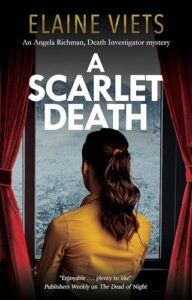
It’s here! A Scarlet Death, my new Angela Richman, Death Investigator mystery. Buy A Scarlet Death hardcovers and ebooks at:
Barnes & Noble: https://tinyurl.com/bde2c7ks
Amazon: https://tinyurl.com/yhtvzns7
Target has the hardcovers here: https://tinyurl.com/5xnrx5n4
Let’s Go To New Zealand
Terry Odell
First, a huge thanks to Kathleen Donnelly and James L’Etoile for filling in during my absence. Loved your posts.
 I was going to jump back with a writing-related post, but let’s be honest. We get those all the time here at TKZ, but how many firsthand posts about a 3 week trip to New Zealand are in the archives?
I was going to jump back with a writing-related post, but let’s be honest. We get those all the time here at TKZ, but how many firsthand posts about a 3 week trip to New Zealand are in the archives?
(Also being honest – I haven’t gotten back to the wip. I printed out the first 25 chapter, which is as much as I’d written before I left, and read them on the rare occasions we had free time, and did my markups. They’re still in the envelope I packed them in.) Another “almost writing” thing? I actually remembered to keep a journal this time, although I have no intention of writing a book based on this trip. And, another moment of honesty—most of my notes were ‘travelogue’ and not the sorts of things I’d use in a novel if I’d planned to write one. Not to mention my longhand has degenerated to the point of bordering on unreadable.
So – New Zealand was a definite bucket list trip. The only improvement would have been to have Scotty beam me to Auckland and then back at the end of the trip. More details here and here.
 We covered almost the entire country, as you can see by the map. The tour lasted 18 days. We also arrived a couple of days prior to our tour to allow for potential delays and to get over jet lag. (There’s a 19 hour plus a day time difference between Auckland and Colorado on the way out. We get that day back on the return trip.)
We covered almost the entire country, as you can see by the map. The tour lasted 18 days. We also arrived a couple of days prior to our tour to allow for potential delays and to get over jet lag. (There’s a 19 hour plus a day time difference between Auckland and Colorado on the way out. We get that day back on the return trip.)
For me, I’d say one of the things I’d want to remember wasn’t so much the experiences, amazing as they were, as it was the education. It was heartening to go to a museum and see group after group of schoolkids with their interest and enthusiasm about the exhibits, all of which were extremely well done. They’re the future.
We were on an organized tour, and didn’t spend a lot of time at any destination, but we covered a lot of destinations. Not just end-of-the-day, here’s your hotel, but numerous stops along the way. Sometimes just for photos—and the scenery was stunning—and sometimes for tours.
Want to follow along? I’ll give you a minute to grab a map or its digital equivalent.
We started in Auckland, but set out for Paihia and the Bay of Islands the next morning. En route, we stopped at Glow Worm Caves and the Waitangi Treaty House where we had our first introduction to the Maori culture and history. (Not my favorite subject in school, and definitely never had classes that touched on the Maori).

Maori Treaty House
Learning about the Maori culture and seeing the efforts being made to keep it alive—and/or recover it—was another positive. Because—going back to something I learned in my college anthropology class—when two cultures collide, the one with the higher technology will overtake the other. Guess who lost out when the white man showed up? That’s pretty much a universal truth.
The Bay of Islands would be a must-see place in the North Island, especially if you can cruise through the “Hole in the Rock”, which we did. We also spent a little time at Otehei Bay on Urupukapuka Island, and some time exploring the town of Russell. (You finding all these locations? How’s your Maori?)
(Clicking should enlarge images.)
We had a fun ride on the Glenbrook Vintage Railway, run by volunteers in period dress, and offering a light tea service. From there, by coach to Rotorua with a stop at the Hamilton Gardens.
Rotorua is another “must” stop, although a bit odiferous from all the sulfur. We walked through a redwood forest, stopped at the Blue and Green Lakes (although the lighting wasn’t conducive to the markedly different colors between the two.
The Te Puia center was a “don’t miss.” A kiwi breeding center, geysers, bubbling mud, a fantastic buffet dinner and Maori entertainment. All well done, but the bottom line is this is a school where they’re trying to keep the Maori arts alive. Students are vetted, and they take very few each year.
The next day was spent in travel. We took the Northern Explorer train from Hamilton to Wellington, which was our southernmost stop in the North Island. There are a lot of sheep and cows in New Zealand. And green. Everything is so green. Ferns everywhere, many the size of trees.
For our final day on the North Island, we took a gondola that rose a whopping 120 meters. (For someone who lives at 9100 feet, this was barely a hill), but at the top, we enjoyed a view of Wellington and roamed the Wellington Botanic Gardens, followed later that day with a guided tour of the Museum of New Zealand, Te Papa Tongarewa. Another educational and interesting experience, with more exhibits focusing on the historic culture and how it can coexist with the current day. Artists created their “updated” version of a meeting house.
That’s it for the North Island. If there’s interest, I can report on our South Island adventures another time.
Okay, a little about writing so I don’t feel too guilty. Although I’m not planning a novel set in New Zealand, the people on the tour provided lots of character fodder for other books. The woman whose cackle would put Phyllis Diller’s to shame. Her husband called her his locator beacon. Or the woman who kept “losing” her husband. “Has anyone seen Tim? Where are you, Timbo?”
Then there was the woman who was severely visually impaired, yet who, with the help of her husband—and everyone else in the group—did and saw everything. I felt it was inappropriate to ask what her specific conditions were—she had other physical issues, but she took pictures with her phone, and said she enjoyed the views, and she talked about many other trips she and her husband had taken.
Or the Brit who refused to try anything new when it came to food, and subsisted on potatoes and “puddings” for much of the trip. The man who was first off the bus, roamed the farthest to take pictures (with his phone), and the last back on. The elderly couple who wore matching clothes and held hands as they walked. Or the one who seemed to wear one of the same two shirts every day, but when I brought it up—obliquely—she said she had four of them.
The floor is yours. Comments? Questions? Personal adventures?
How can he solve crimes if he’s not allowed to investigate?
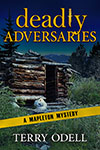 Gordon Hepler, Mapleton’s Chief of Police, has his hands full. A murder, followed by several assaults. Are they related to the expansion of the community center? Or could it be the upcoming election? Gordon and mayor wannabe Nelson Manning have never seen eye to eye. Gordon’s frustrations build as the crimes cover numerous jurisdictions, effectively tying his hands.
Gordon Hepler, Mapleton’s Chief of Police, has his hands full. A murder, followed by several assaults. Are they related to the expansion of the community center? Or could it be the upcoming election? Gordon and mayor wannabe Nelson Manning have never seen eye to eye. Gordon’s frustrations build as the crimes cover numerous jurisdictions, effectively tying his hands.
Available for preorder now.
 Terry Odell is an award-winning author of Mystery and Romantic Suspense, although she prefers to think of them all as “Mysteries with Relationships.”
Terry Odell is an award-winning author of Mystery and Romantic Suspense, although she prefers to think of them all as “Mysteries with Relationships.”